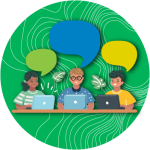
In my years doing reading help for the Library, I have seen many different types of kids who need help with reading. By far the most common are the kids who I suspect are kinesthetic (hands-on) learners.
People learn in many different ways—some of us learn through reading a book, some through watching others perform a task, some through listening to instructions. Another type of learner learns through movement and from doing things with their bodies. These learners are athletes, dancers, builders, artists, and even actors. They all learn by doing things, not by reading or listening.
For these learners, reading can be a challenge because reading is a sedentary activity. I had one young reluctant reader tell me he hated reading because holding a book was like “wearing handcuffs.” This young reader liked to build.
Many of the kids who come to our Reading Help program excel at soccer, ballet, drawing, acting, and building things. The common denominator is they all like to do things with their hands and/or bodies. Reading does not allow them to do that. Reading is often done sitting down with a book in your hand. It’s the opposite of what these kinesthetic learners like to do!
So, what can you do to help a young reader who you suspect is a kinesthetic learner?
Audiobooks. Listening to books is still reading! Your struggling reader may not see the words on the page, but they can hear the story and understand how language and stories work.
Audiobooks are great for the car, especially if you can find a story everyone will like. The library also has downloadable audiobooks for your phone or device, so your young reader can listen to a book anywhere.
Read aloud. Parents can keep reading to their kids even when they are older. Kids like to have stories read to them! If your child is older, choose a book that interests them but is beyond their ability to read independently. This way they can hear a story they enjoy and learn from listening to you read the words.
If you are reading to them, pause to allow them to ask questions or to ask questions yourself. One way to help a struggling reader is through modeling—if you have a question like, “I wonder if the hero will ask her friends for help?” ask it aloud so your child knows even experienced readers have questions when reading.
*If English is not your primary language, then find books to read aloud in your native language. Hearing stories in any language is good for kids!
Let them play. Allow your reluctant reader to play while you either read to them or they listen to an audiobook. If you have a child who loves to build with Lego, let them! They can play and listen at the same time.
It might look like they are not paying attention, but they mostly like are. If in doubt, you can always ask them questions about the book. Be prepared to be surprised by how much they heard!
Let them fidget. For many kinesthetic learners, they learn better when they are moving, so fidgeting helps them to pay attention. Fidgeting can actually help their learning.
Have them draw. If your child likes to draw, have them draw what they hear in the story. You might be surprised by how well they understand not only what is happening on the surface of the story but also the themes underneath.
Take Breaks. During those times when your kinesthetic learner has to sit and do reading, like for a homework assignment, let them take regular breaks. A 20-25-minute block of reading is about as much as they can do. After that, give them a break to get up and move around.
Be Creative. If your child is listening to you read aloud or is listening to an audiobook, have them walk around while your read. If you have a whiteboard in your home, let them draw on it, even if it’s nothing more than scribbling. Whiteboards are also great for working on math homework (easily erased) or brainstorming for an essay. If they are reading on their own, see if you can find different ways for them to sit, like a bean bag chair or an exercise ball.
Let them do anything that keeps their bodies moving while they read. If your child likes to act or perform, encourage them to really get into the voices while they read. They could even act out a scene!
The most important thing to remember is that kinesthetic learners need movement. If your child is a reluctant reader and they’d rather be outside playing soccer or at an easel drawing, try some of the above suggestions and you might find them reading for pleasure.
 Need more help with math? Visit Learn at Home for even more great resources, including:
Need more help with math? Visit Learn at Home for even more great resources, including:
- Free online tutoring
- Online tools available 24x7x365
- Recommended items from our collection that you can pick up curbside

